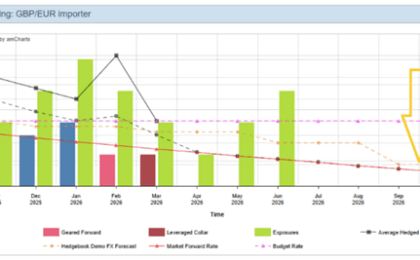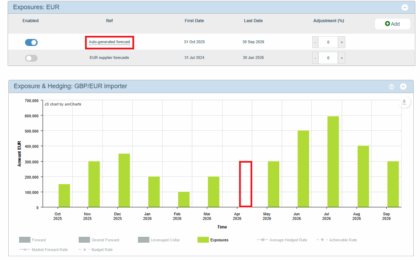At Hedgebook we are often asked by our clients what the appropriate credit spreads are when calculating CVA (Credit Value Adjustment) under the current exposure method. The current exposure method requires a credit spread over the risk-free rate (swap rates) to determine the discount factor for future Cashflows.
Current exposure method
The current exposure method is appropriate for calculating credit adjustments for vanilla financial instruments such as foreign exchange forwards and options, and interest rate swaps. If your derivatives are in-the-money then the credit valuation adjustment quantifies the risk of your counterparty defaulting.
One appropriate source for quantifying appropriate credit spreads is the Credit Default Swaps (CDS) market. A CDS is a financial agreement between two parties whereby the buyer of the CDS will be compensated by the seller in the event that the issuer (bank in this case) defaults on the debt. The CDS market on bank debt is an extremely deep and liquid market and provides a good guide to how the market views its creditworthiness. CDS spreads can be used in the calculation of CVA.
Credit spread overview for ANZ
For our NZ/Australian users the following table shows the CDS spreads for the four main Australian banks:
| ANZ | CBA | NAB | Westpac | |
| 1 year | 5 | 5 | 6 | 7 |
| 2 year | 9 | 9 | 10 | 11 |
| 3 year | 13 | 13 | 14 | 15 |
| 5 year | 24 | 24 | 25 | 26 |
| 10 year | 43 | 43 | 44 | 45 |
* bp = basis points per annum. 1bp = 0.01% (Source: Refinitiv as at 15 September 2021)
As each of these Australian banks is rated AA- by S&P it is intuitive that the CDS trades within close proximity to each other. If you have more than one counterparty then you do not necessarily need a credit curve for each one. It is only important to have different curves for different counterparties if they have different credit ratings.
Overview for the UK
For our UK users the following table shows the benchmark CDS spreads for AA, A and BBB rated banks. Using S&P long-term credit ratings, of the five main UK banks Barclays and Santander have the strongest credit rating (A), followed by HSBC (A-), Lloyds (BBB+) and NatWest (BBB).
| AA | A | BBB | |
| 1 year | 9 | 15 | 20 |
| 2 year | 13 | 20 | 27 |
| 3 year | 18 | 25 | 33 |
| 5 year | 31 | 39 | 55 |
| 10 year | 52 | 60 | 86 |
* bp = basis points per annum. 1bp = 0.01% (Source: Refinitiv as at 15 September 2021)
The reality is that the CVA calculation is not very sensitive to these inputs so it is not necessary for a corporate with vanilla instruments to agonise over the credit assumptions. That said, the assumptions must be defensible and, more importantly from an IFRS 13 perspective, observable.
The CVA module within the Hedgebook app allows the user to create multiple credit curves and assign them appropriately to the relevant instruments. However, creating multiple curves will only be of added value if the counterparties are of materially different credit standing. As always – if you’d like to know more – please don’t hesitate to get in touch.





